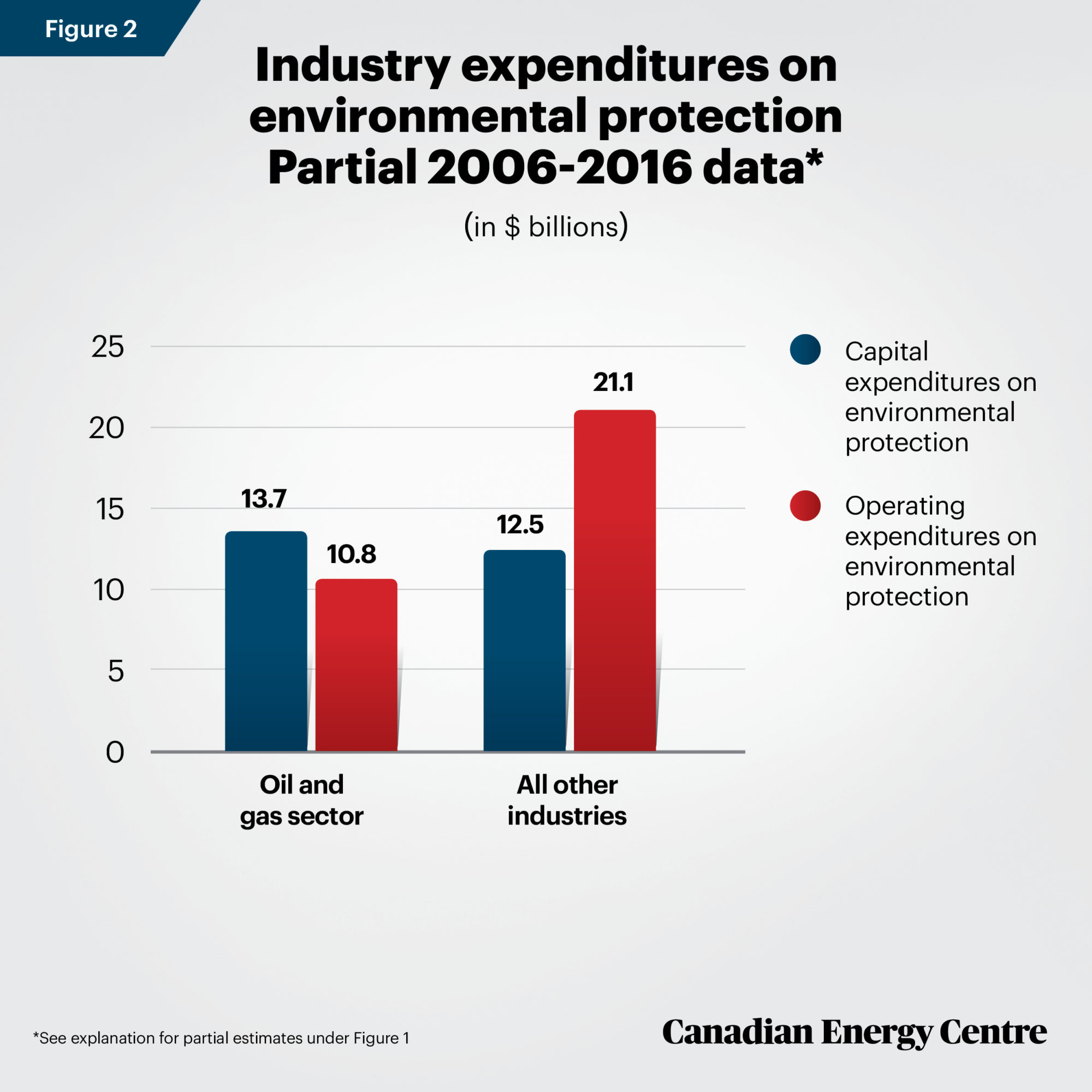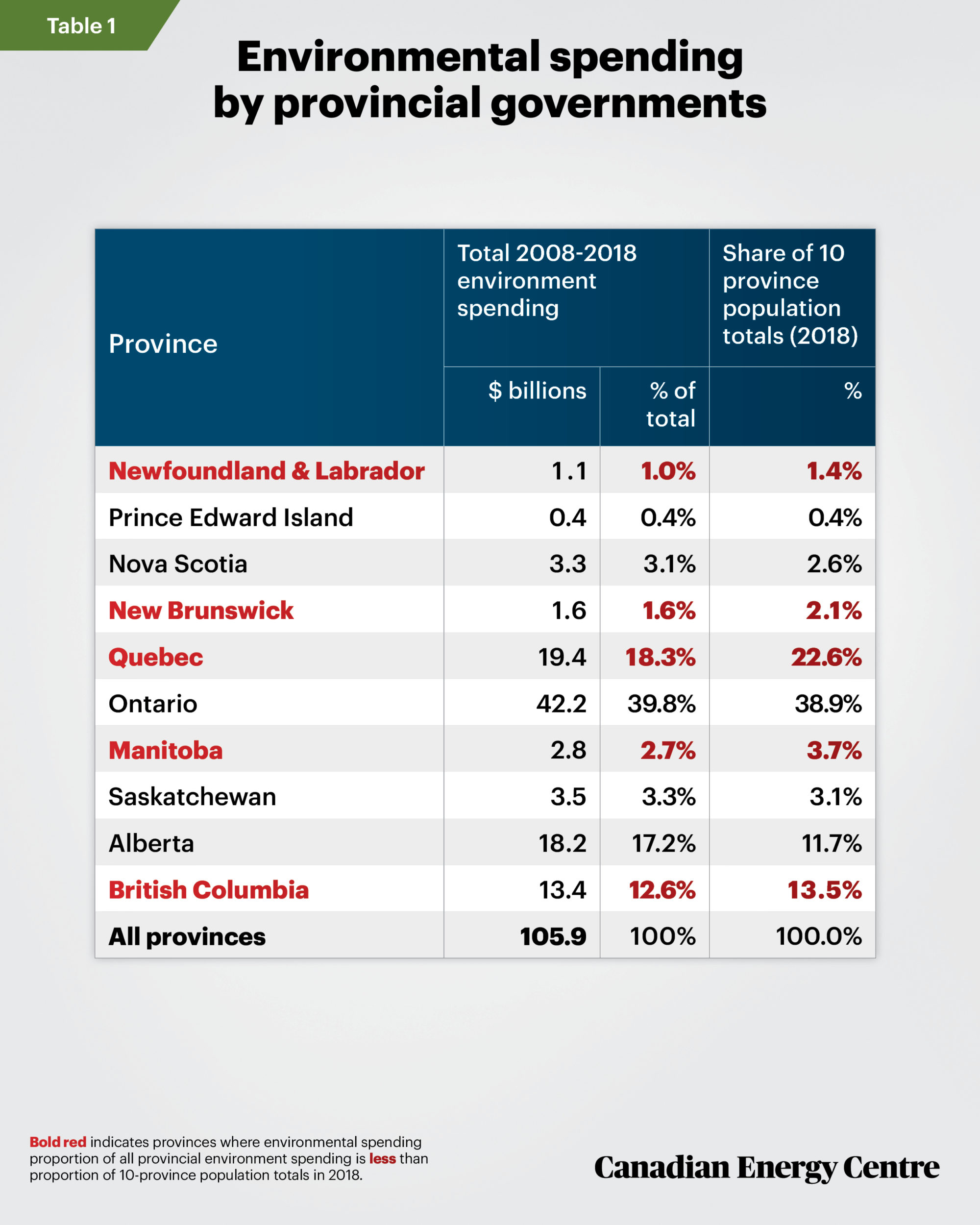Updated by Ven Venkatachalam, Lennie Kaplan and Mark Milke
Follow CEC on Linkedin CEC Linkedin
Follow CEC on Facebook CEC Facebook
Follow CEC on Twitter CEC Twitter

Environmental spending in Canada
This Fact Sheet (which can be downloaded here as a pdf) details spending on environmental protection by the oil and gas sector, other industries, and provincial governments. The comparisons are made using the most recent data from Statistics Canada. For industry expenditures, data from 2006 to 2016 are available but only on a bi-annual basis. For provincial government spending, data are available from 2008 to 2018 on an annual basis.
Among other expenditures, environmental protection spending encompasses everything from reclamation and decommission of abandoned and orphan wells, to the installation of pollution prevention processes and technologies and also environmental audits and wildlife protection.
As the data makes clear, the oil and gas sector in Canada spent the most of any industry—$24.5 billion or more than four times the next highest spender, electric power generation at $5.6 billion. As for governments, Alberta spent $18.2 billion on environmental protection between 2008 and 2018. Measured per capita, Alberta’s spending on environmental protection regardless of the party in power was higher than the average of the other nine provinces in every year. As one example, In the most recent year for which data is available, Alberta spent
$415 per capita in 2018 on environmental protection; that was 139 per cent of the nine-province average of $298 per capita.
Comparison One: Environmental protection spending by industry
Figures 1 and 2 show partial estimate of industry spending based on Statistics Canada data, which is only reported for every second year.
- For total spending, i.e., when capital and operating expenses on environmental protection in Canada are combined, out of $58 billion spent in total between 2006 and 2016:
º The oil and gas sector spent $24.5 billion or 42 per cent while all other industries combined spent $33.5 billion or 58 per cent;
º Those other major industries include electric power generation ($5.6 billion or 10 per cent); mining and quarrying ($5.3 billion or nine per cent) net primary metal manufacturing ($5.1 billion or nine per cent) and chemical manufacturing ($2.6 billion or about four per cent);
º The remaining industries spent $14.9 billion or 26 per cent.

Source: Statistics Canada Table 38-10-0042-01
Breakdowns by capital and operating
- Capital spending¹: The oil and gas sector was responsible for 52 per cent ($13.7 billion) of all capital spending for environmental protection compared with 48 per cent for all other industries together ($12.5 billion);
- Operating spending²: The oil and gas sector was responsible for 34 per cent ($10.8 billion) of all operating spending for environmental protection compared with 66 per cent for all other industries together ($21.1 billion).
1. Capital spending includes outlays on machinery and equipment and for the construction of non-residential facilities, among other expenditures. 2. Operating spending includes expenses incurred for labor, materials and supplies, maintenance and repair, among other expenditures.

Source: Statistics Canada Table 38-10-0042-01
Gaps in data which lead to underestimates of environmental spending
Statistics Canada measures environmental spending by companies only every second year. Thus, half of the environmental spending data (both capital and operating expenses) for industries is absent. Assuming that the missing years equal the previous year’s spending, environmental spending between 2006 and 2017 (adding the year to parallel 2016) could have amounted to $116 billion. In that scenario, oil and gas spending would equal $49 billion on the environment with all other industries estimated at $67 billion.
Comparison Two: Environment spending by the provinces, 2008-2018
Environmental protection spending is incurred by governments as well as industries. Table 1 shows total provincial government environment spending between 2008 and 2018 to be nearly $106 billion. (The federal government and the territories are excluded in this comparison.) As a proportion of all environmental spending, four provinces spent more relative to their share of population totals:
- Alberta spent $18.2 billion or 17.2 per cent of all provincial expenditures on the environment while its proportion of the (10-province) population was 11.7 per cent as of 2018.
- Ontario spent $42.2 billion or 39.8 per cent of all provincial expenditures while its proportion of the population was
38.9 per cent as of 2018. - The other two provinces that spent a higher proportion on the environment relative to population were Nova Scotia and Saskatchewan.
- Five provinces spent less on the environment than their share of the population: Quebec, British Columbia, Manitoba, New Brunswick, and Newfoundland & Labrador. The Quebec government in particular spent just 18.3 per cent of all provincial environment expenditures between 2008 and 2018, significantly below its 22.6 per cent share of the (provinces’) population in 2018.
- One province, Prince Edward Island spent parallel to its share of provincial population totals.

Sources: Statistics Canada Table 10-10-0005-01 and Table 17-10-0005-01.
A per capita look at provincial spending on the environment
Table 2 illustrates all provincial spending on environmental protection between 2008 and 2018 inclusive. Of note:
- Alberta spent more per capita on environmental protection than any other province in every year with one exception in one year: Nova Scotia in 2009.
- When the annual average of the other nine provinces is compared, Alberta spent substantially more than the annual average of all the other provinces on environmental protection in every year.
Table 2 and Figure 3 also show the following:
- In 2018, Alberta’s spending on the environment at $415 per capita was 128 per cent of the amount spent by Ontario ($323): 137 per cent of that spent by British Columbia ($303); 139 per cent of the nine-province average ($298); and 154 per cent of what was spent by Quebec spent ($270).³
3. The spike in environmental spending in Alberta in 2016 was due to $1.1 billion in new spending from the province’s Climate Leadership Plan. (Source: Statistics Canada 2018.)

Sources: Statistics Canada Table 10-10-0005-01 and Table 17-10-0005-01.

Sources: Statistics Canada Table 10-10-0005-01 and Table 17-10-0005-01.
Takeaway One: Environment spending highest by oil and gas industry and by Alberta
When measured as a proportion of $58 billion in all industry spending on environmental protection between 2006 and 2016, not including “gap” years in Statistics Canada data, Canada’s oil and gas sector spent $24.5 billion, or 42 per cent. All other industries in Canada were responsible for $33.5 billion or 58 per cent of such spending.
When provincial government spending is examined, with data available from 2008 to 2018, Alberta spent significantly more than its share of Canada’s population ($18.2 billion or 17.2 per cent of all provincial spending with a population at 11.7 per cent of provincial totals). This is also true when per capita spending is examined: Alberta’s environmental protection spending was significantly higher than the average of the other nine provinces for the entire 2008-2018 period.
Takeaway Two: $43 billion in environmental spending is substantial
One last takeaway to consider: Criticism that the oil and gas industry and the provinces where its presence is substantial— Alberta, (northern) British Columbia, Saskatchewan, Newfoundland & Labrador—should spend substantial amounts on environmental protection given industry’s environmental impacts. It is not clear why that claim would apply mainly to energy as opposed to manufacturing or even agriculture, which also have substantial impacts, i.e., the erection of a factory on farmland or the clearing of a forest for cropland.
Such considerations aside, the province where the oil and gas sector is largest—Alberta—spent $18.2 billion on environmental protection between 2008 and 2018, while the partial tally for the oil and gas industry between 2006 and 2016 amounted to $24.5 billion. Expressed differently, environmental expenditures by the province of Alberta alone and the oil and gas sector amounted to nearly $43 billion, before including other provinces (Saskatchewan, Newfoundland and Labrador, and British Columbia) where oil and gas extraction also occurs. Nearly $43 billion is not an insubstantial amount and should be noted in any ongoing discussions over the adequacy of industry and government environmental spending in Canada.
About the Canadian Energy Centre (CEC)
The Canadian Energy Centre (CEC) is an independent provincial corporation that is primarily supported by the Government of Alberta’s industry-funded Technology, Innovation and Emissions Reduction (TIER) fund. The CEC’s mandate is to promote Canada as the supplier of choice for the world’s growing demand for responsibly produced energy. At its core, the CEC will also create a new, pragmatic, fact-based narrative about Canadian energy.
Notes
This CEC Fact Sheet was compiled by Ven Venkatachalam, Lennie Kaplan and Mark Milke at the Canadian Energy Centre: www.canadianenergycentre.ca. The authors and the Canadian Energy Centre would like to thank and acknowledge the assistance of Philip Cross in reviewing the data and research for this Fact Sheet. Image credits: ‘Conifer Pine Needles’ by LUM3N
Sources (Links live as of May 7, 2020)
Statistics Canada: Table 38-10-0042-01 <https://bit.ly/2Y65iQi >, Table 10-10-0005-01 <https://bit.ly/2Ypxiyn>; Table 17-10-0005-01 <https://bit.ly/3d03wV5>; Statistics Canada (2018). Government Expenditures in Alberta. A presentation to deputy ministers in Alberta, Anil Arora, February 12, 2018.
Creative Commons Copyright
Research and data from the Canadian Energy Centre (CEC) is available for public usage under creative commons copyright terms with attribution to the CEC. Attribution and specific restrictions on usage including non-commercial use only and no changes to material should follow guidelines enunciated by Creative Commons here: Attribution-NonCommercial-NoDerivs CC BY-NC-ND.
Share This:





 CDN NEWS |
CDN NEWS |  US NEWS
US NEWS 



































COMMENTARY: Activists Suddenly Care About LNG Investors